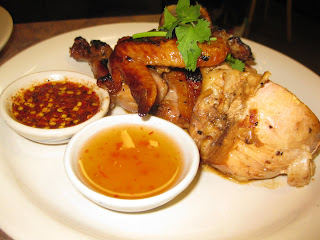
When it comes to burgers, my mentor is Kenji Lopez-Alt, burger guru for
Cook's Illustrated and the burger blog
A Hamburger Today. In his quest to perfect burger science, Kenji estimates he's made 1,100 burgers over the last 2 1/2 years, averaging 1.2 burgers per day. His wife actually forced him to move apartments because the smell of burgers permeated the walls. Read Kenji's 10 tips on making a better burger
here, the most important of which I've distilled into three:
1.
Grind your own beef. Buying supermarket ground beef is a crapshoot. You don't know when it was ground, what part of the cow it came from, or how many different cows are in the package. What's more, it's typically overprocessed, leading to a dry, rubbery burger. You can ask your butcher to grind you meat, or you can do it easily enough with a food processor. When grinding your own meat, you take control of the flavor and fat content. In Cook's Illustrated, Kenji recommends
a blend of sirloin tips and short rib for the ideal balance of fat and beefiness; he has also devised what he calls the
Blue Label Blend of sirloin, brisket and oxtail.
2.
Handle the burgers as little as possible. This runs counter to many people's practices, but working the meat causes proteins to cross-link like tiny strips of velcro, making the finished burgers denser and tighter with every manhandling of the grind.* Kenji has found that the best and juiciest burgers result from grinding the meat directly onto a cold baking sheet, then gently coaxing it into loose patties without ever picking it up until just before cooking.
3.
Salt meat only after patties are formed. Salt dissolves muscle proteins, turning the burgers from moist and tender to springy and sausage-like. The effect is dramatic,
as you can see here. Of course, after you have formed your patties, salt and pepper them liberally just before cooking.
*You may be wondering at this point how you are going to add your favorite spice blend without working the meat. I used to believe that a good burger incorporated fresh herbs, garlic, etc. But once you begin grinding your own meat, you'll find that the beefy flavor shines on its own with embellishment. Kenji says: "Adding junk like onions, herbs, breadcrumbs, anything to your ground meat not only forces you to over-handle the mix, but it instantly relegates your burgers into the "meatloaf sandwich" category. If you absolutely must add junk to your burgers, mix it with the cubes of beef (but don't add the salt yet!) prior to grinding."
Without further ado, monkey's backyard burgers, guided by Kenji Lopez-Alt:
1. Put your food processor in the freezer. Cut 10 ounces of sirloin tips and 6 ounces of b

oneless short ribs (do not trim the fat) into 1-inch cubes, place on a baking sheet and freeze 15-25 minutes. During this time you can assemble fixings and get the fire lit.
2. Coarsely grind the meat in two batches, using about 15 pulses and redistributing the meat around the bowl as necessary to ensure it is evenly ground. Overturn the meat onto the cold baking sheet without touching it. Inspect the meat carefully, discarding any long strands of gristle or large chunks of hard meat or fat.
3. Gently separate

the ground meat into three equal mounds. Without picking it up, shape each mound into a loose patty, leaving edges and surface ragged. Season the top of each patty generously with salt and freshly ground pepper. Flip patties with a spatula and season the other side.
4. Grill the burgers over direct heat about 4 minutes a side for medium rare. Brush sliced onions with olive oil and salt and

grill those if you like (these will take longer than the meat). Add cheese to the burgers in the last minute of cooking, place onto buns and garnish as you like. I like greens, tomatoes when in season, grilled onions and
Wicked Natural ketchup.
 This dish is a takeoff on Marcella Hazan's lamb stew with vinegar and green beans. I made the substitution after buying humanely raised stewing veal from a nice man at the Roslindale farmer's market, and damned if it wasn't some of the best, most flavorful meat I've ever had. When I sauteed the onion, I threw in some lovely green garlic from the farm as well. Nutty brown rice was the perfect foil for the tangy, juicy meat.
This dish is a takeoff on Marcella Hazan's lamb stew with vinegar and green beans. I made the substitution after buying humanely raised stewing veal from a nice man at the Roslindale farmer's market, and damned if it wasn't some of the best, most flavorful meat I've ever had. When I sauteed the onion, I threw in some lovely green garlic from the farm as well. Nutty brown rice was the perfect foil for the tangy, juicy meat. g the vinegar to a brisk simmer for 30 seconds, turning the meat and scraping loose brown bits from the pan with a wooden spoon. Turn the heat down to cook at a slow simmer, add the green beans with a little more salt and pepper, and cover the pot with the lid slightly ajar.
g the vinegar to a brisk simmer for 30 seconds, turning the meat and scraping loose brown bits from the pan with a wooden spoon. Turn the heat down to cook at a slow simmer, add the green beans with a little more salt and pepper, and cover the pot with the lid slightly ajar.















































